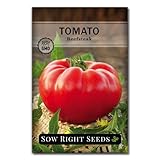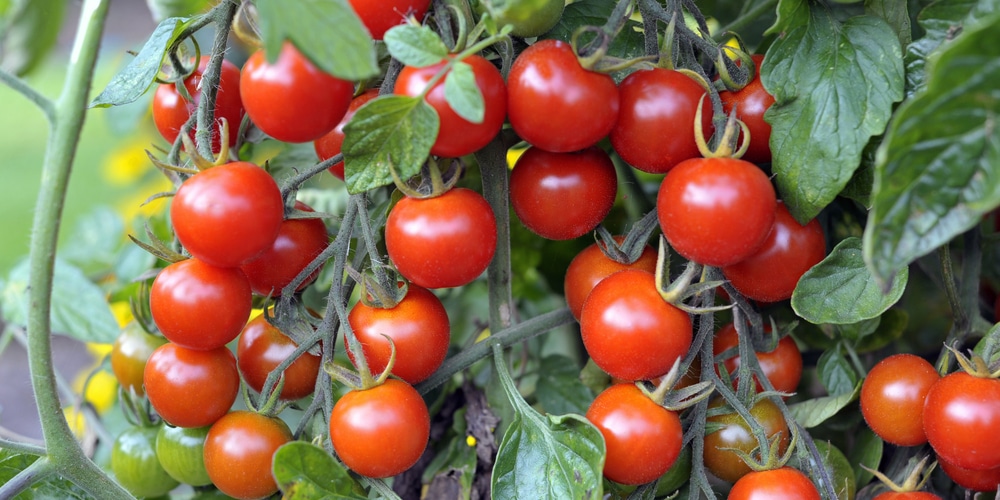| Question | What’s the best time of year to plant tomatoes in New Mexico? |
|---|---|
| Answer | Varies by region: March in the south, late April to May in the north. |
| More Info |
|

The best time to plant tomatoes in New Mexico varies significantly due to the state’s diverse climate zones, which range from desert to high mountain areas.
Generally, in the warmer southern regions, tomatoes can be planted outdoors as early as March. In the central and northern parts of the state, it’s safer to wait until late April or even early May, after the risk of frost has passed.
Starting seeds indoors 6-8 weeks before the expected outdoor planting date is beneficial across New Mexico to ensure the seedlings are strong enough for transplanting. Given the state’s hot summers, selecting heat-tolerant tomato varieties and providing adequate water and sun protection during the peak heat will help ensure a productive harvest.
New Mexico’s Climate Zones
New Mexico’s climate is characterized by hot summers and mild winters, making it an ideal environment for growing tomatoes. The state falls within USDA hardiness zones 4b to 9b, which means that the growing season can vary significantly depending on your specific location.
In general, the southern part of the state has a longer growing season than the northern part. The southern part of New Mexico is characterized by a hot, arid climate, while the northern part of the state is cooler and more humid.
To determine the best time to plant tomatoes in New Mexico, it is important to understand the different climate zones in the state.
The following table provides a summary of the USDA hardiness zones in New Mexico:
| Zone | Average Minimum Temperature |
|---|---|
| 4b | -25 to -20°F |
| 5a | -20 to -15°F |
| 5b | -15 to -10°F |
| 6a | -10 to -5°F |
| 6b | -5 to 0°F |
| 7a | 0 to 5°F |
| 7b | 5 to 10°F |
| 8a | 10 to 15°F |
| 8b | 15 to 20°F |
| 9a | 20 to 25°F |
| 9b | 25 to 30°F |
As can be seen from the table, New Mexico has a wide range of climate zones, from very cold in the north to very warm in the south. This means that the best time to plant tomatoes can vary significantly depending on where you are located in the state.
In general, gardeners in the southern part of the state can plant tomatoes earlier in the season than those in the northern part of the state.
It is also important to consider the specific microclimate of your garden, as this can have a significant impact on the growing season and the success of your tomato plants.
Optimal Planting Times for Tomatoes in New Mexico
New Mexico has a unique climate that makes it possible to grow tomatoes almost all year round. However, the best time to plant tomatoes in New Mexico is during the spring and fall seasons.
Spring Planting Guidelines
In most parts of New Mexico, the last frost date occurs in early to mid-April.
Therefore, it is recommended to plant tomato seeds indoors about 6-8 weeks before the last frost date. This will allow the seedlings to grow and develop before they are transplanted into the garden.
When transplanting the seedlings into the garden, make sure that the soil temperature is at least 60°F. This will help the plants to grow and thrive.
Additionally, it is important to water the plants regularly and provide them with adequate sunlight.
Fall Planting Possibilities
Fall is also a good time to plant tomatoes in New Mexico.
The optimal time to plant tomatoes in the fall is around late summer or early autumn. During this time, temperatures are still warm enough for the plants to grow and mature.
When planting tomatoes in the fall, make sure to choose a variety that has a shorter growing season. This will ensure that the plants have enough time to mature before the first frost date.
Additionally, it is important to provide the plants with adequate water and sunlight.
Preparing the Soil for Tomato Planting
Before planting tomatoes in New Mexico, it is important to prepare the soil properly. This will ensure that the plants have the necessary nutrients and growing conditions to produce a bountiful harvest. Here are some tips to get started:
Test the Soil
The first step in preparing the soil is to test its pH level.
Tomatoes grow best in slightly acidic soil with a pH level between 6.0 and 7.0. A soil test will help determine the pH level of the soil.
If the pH is too high (over 7.0), add sulfur. If the pH is too low (below 6.0), add lime.
Add Organic Matter
Adding organic matter to the soil is essential for healthy tomato plants.
Compost, manure, or leaf mulch are all great options for improving soil structure and retaining moisture. These materials can be added to the soil before planting or worked into the soil during the growing season.
Loosen the Soil
Tomato plants have deep roots and need loose soil to grow properly.
To ensure that the soil is loose, it is recommended to till or loosen the soil to a depth of at least 12 inches. This will allow for root expansion and better water and nutrient absorption.
Incorporate Necessary Fertilizers
Before planting, make sure to incorporate necessary fertilizers or soil amendments, such as calcium and magnesium.
These nutrients are essential for healthy plant growth and fruit production. It is recommended to follow the instructions on the fertilizer or amendment package for best results.
Selecting Tomato Varieties for New Mexico
When it comes to selecting tomato varieties for New Mexico, it is important to choose ones that can withstand the state’s unique climate and growing conditions. The intense heat, arid conditions, and short growing season require tomato plants that can thrive in these conditions.
Here are some tomato varieties that are well-suited for growing in New Mexico:
1. Early Girl
Early Girl is a popular variety of tomato that is well-suited for New Mexico’s climate.
It is an early-maturing variety, typically producing fruit within 50-60 days of planting. Early Girl tomatoes are medium-sized, with a sweet and tangy flavor.
2. Sun Gold
Sun Gold is another great tomato variety for New Mexico.
This variety produces small, sweet, and flavorful tomatoes that are perfect for snacking. Sun Gold tomatoes are also resistant to many tomato diseases, making them a great choice for gardeners who want to avoid using pesticides.
3. Roma
Roma tomatoes are a popular choice for making sauces and canning.
They are meaty and flavorful, with few seeds. Roma tomatoes are also well-suited for New Mexico’s climate, as they are resistant to many tomato diseases and can withstand high temperatures.
4. Celebrity
Celebrity tomatoes are a determinate variety, meaning they grow to a certain height and then stop.
This makes them a great choice for gardeners with limited space. Celebrity tomatoes produce medium-sized fruit that is juicy and flavorful.
Tomato Plant Care and Maintenance
Growing tomatoes in New Mexico can be a rewarding experience, but it requires proper care and maintenance to ensure a successful harvest. Here are some tips to help you care for your tomato plants:
Watering
Tomatoes require consistent watering to thrive. In New Mexico’s hot, dry climate, this is especially important.
Tomato plants should be watered deeply and regularly, with the soil allowed to dry out slightly between waterings. Overwatering can lead to problems such as root rot and fungal diseases.
Fertilization
Tomatoes are heavy feeders and require regular fertilization to produce a healthy crop.
A balanced fertilizer with equal amounts of nitrogen, phosphorus, and potassium is recommended. Fertilizer should be applied every two to three weeks during the growing season.
Pest Control
Tomatoes are susceptible to a variety of pests, including aphids, whiteflies, and tomato hornworms.
Regular inspection of the plants can help detect any infestations early. Insecticidal soap or neem oil can be used to control pests.
Pruning
Pruning tomato plants can help improve air circulation and reduce the risk of disease.
Suckers, the small shoots that grow between the stem and the branch, should be removed regularly. This will encourage the plant to put more energy into producing fruit.
Support
Tomato plants need support to keep them upright and prevent them from falling over.
Staking or caging the plants can help support the weight of the fruit and prevent damage to the plant.
Frequently Asked Questions
What is the optimal planting time for tomatoes in Albuquerque?
The optimal time for planting tomatoes in Albuquerque is after the last frost date, which is usually around mid to late April.
It is important to wait until the soil has warmed up to at least 60°F before planting tomatoes.
Which month is considered best for starting tomato cultivation in New Mexico?
Starting tomato cultivation in New Mexico is usually best in March, as it allows ample time for the seedlings to grow before the optimal planting time in April. However, this may vary depending on the specific location and climate conditions.
How does the New Mexico planting calendar influence tomato planting dates?
The New Mexico planting calendar provides useful information on when to plant various crops, including tomatoes.
It takes into account the climate and soil conditions in different regions of the state and provides guidance on the optimal planting times for different crops.
What are the recommended vegetables to grow alongside tomatoes in New Mexico?
Some of the recommended vegetables to grow alongside tomatoes in New Mexico include peppers, cucumbers, beans, and squash.
These vegetables have similar soil and climate requirements and can be grown together to maximize space and yield.
How early in the year can one safely transplant tomato seedlings outdoors in New Mexico?
Tomato seedlings can be safely transplanted outdoors in New Mexico after the last frost date, which is usually around mid to late April.
However, it is important to wait until the soil has warmed up to at least 60°F before transplanting the seedlings.
What are the specific considerations for planting tomatoes in New Mexico’s zone 7?
In zone 7, which includes Albuquerque and other parts of New Mexico, it is important to choose tomato varieties that are well-suited to the hot and dry climate.
It is also important to provide ample water and nutrients to the plants, as they require consistent watering to thrive.
Additionally, it is recommended to plant tomatoes in well-draining soil and to provide some shade during the hottest parts of the day.
Last update on 2025-06-06 / Affiliate links / Images from Amazon Product Advertising API







